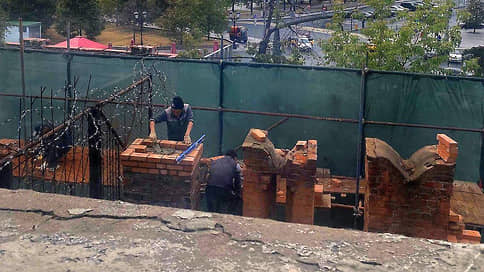The Moscow Department of Cultural Heritage explained the construction work on the Kitaigorod wall
[ad_1]

On the historical part of the Kitaigorod wall in the center of Moscow, eyewitnesses discovered ongoing construction work with the dismantling and replacement of brickwork on the battlements of the structure. This, in particular, was reported with concern in internal chats by students of the Historical and Archival Institute of the Russian State Humanitarian University (located next to the wall on Nikolskaya Street).
A monument of medieval Russian fortification – the red-brick Kitai-Gorod wall on a white-stone plinth – was built under the guidance of the Italian architect Petrok Maly in 1534–1538. Initially, the fortress wall around the Moscow Kitai-Gorod had 12 towers and a length of 2567 m. At present, there is only one original 250-meter fragment of the wall (6 m high) in Theater Drive behind the Metropol Hotel.
The Moscow Department of Cultural Heritage, where Kommersant asked for comments on the construction work, explained that it was a “long-awaited restoration.” “The work is being carried out on the basis of a project, a permit issued and under the supervision of specialists from the Moscow Department of Cultural Heritage. The project contains a cartogram with a fairly large amount of late brickwork to be replaced (repaired),” the department explained. The Moscow Department of Cultural Heritage added that the work began in July 2022 and will last until the end of the year.
The approval of the project for the restoration of a 250-meter section of the wall in the Moscow Architectural Council was reported in January 2020. In the course of the work, it was supposed to remove the floors of the stoves and door blocks as “late elements that distort the historical appearance of the monument”, strengthen the foundations, recreate the white stone base and renew the vaults of the stoves. “A separate stage will be the renewal of the brick walls: experts will repair the bricks, close up the cracks and treat everything with protective compounds,” the Moscow Architectural Council explained then. The chief architect of the restoration and construction company “Architectural heritage” Natalya Kartashova called the Kitaigorod wall an important monument of medieval Russian fortification and a rather complex object. According to her, in the 1920s and 1930s, “a large percentage of the brickwork elements were replaced with new ones.” Until recently, there were many emergency sections on the wall with “cracks, destruction and partial loss of bricks.” “The project provides for the replacement of some sections of the brickwork of the 1930s and later, which are in disrepair,” Ms. Kartashova added.
[ad_2]
Source link








